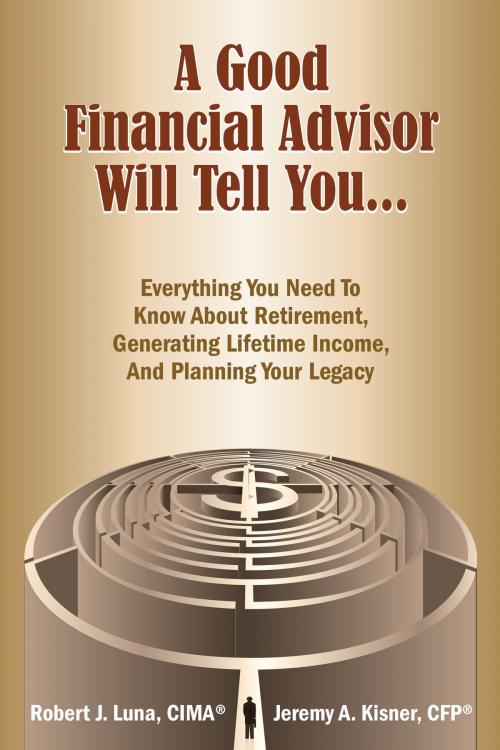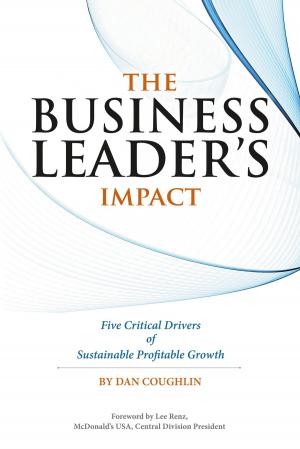A Good Financial Advisor Will Tell You...
Everything You Need To Know About Retirement, Generating Lifetime Income And Planning Your Legacy
Business & Finance, Personal Finance, Investing, Finance & Investing| Author: | Jeremy A. Kisner, CFP, Robert J. Luna, CIMA | ISBN: | 9781618427458 |
| Publisher: | BookBaby | Publication: | December 6, 2011 |
| Imprint: | Language: | English |
| Author: | Jeremy A. Kisner, CFP, Robert J. Luna, CIMA |
| ISBN: | 9781618427458 |
| Publisher: | BookBaby |
| Publication: | December 6, 2011 |
| Imprint: | |
| Language: | English |
Let’s start with what this book is not. This book is not an “introduction to investing” book. Millions of those are out there, and they typically put people to sleep. Therefore, this book is not going to explain: What is a stock? What is a mutual fund? How do you create a family budget? Yada, yada, yada. This book was written for the millions of people who could be called the “mass affluent”—those hardworking, successful individuals and families who have managed to accumulate $500,000 to $10,000,000, and those who are focused upon working toward that kind of affluence. Through meetings with hundreds of current and prospective clients, we have seen how people accumulate small fortunes, and then frequently lose a good portion of them through bad investments and poor planning. Once people retire, they frequently roll over retirement accounts that were administered by their employer to an IRA where they have full control. They also sell businesses or real estate and have a lump sum of money to invest. Most people have never been in the position to invest in this way before, or at least not at this level, and not when the stakes are so high. In fact, most people’s largest assets (in order) are their home, their company retirement plan, and then cash value life insurance. What do those three assets have in common? You typically don’t look at their value every day, and they are not considered liquid by most of their owners. What many people fail to realize when they retire is that they have just employed themselves to become the pension fund manager for themselves and their family’s future. What that means is they may no longer have the luxury of not needing to take income from their investments. When you are in this situation, your investment portfolio has in essence become your employer. The performance of your portfolio will now dictate in large part the lifestyle that you and your family can enjoy in the future. If your portfolio does not generate enough income, you no longer have the option of just working more hours or taking on a side project. Your portfolio is more important now than ever, as are other financial decisions you will be making. You have entered the major leagues of investing and you are up to bat. The questions you now need to ask are: • How should I change my investment mix? • How much can I afford to take from my account on a monthly or annual basis? • From which investments should I take the money? Professional pension fund managers face these questions each day. You now have a decision to make—you can either answer these questions for yourself, or you can hire a professional to answer them for you. It’s a tough decision whether to manage your investments yourself or to hire a professional. If you are considering doing it yourself, you should be aware of some of the mistakes we frequently see among do-it-yourself-ers. The investing failures are not due to people being stupid. The majority of people we meet and work with are quite bright. Many of our clients are Ph.D.’s, engineers, lawyers, CPA’s, successful business owners and college professors. The reason why most people make poor investors is that they are human. Human beings are hard-wired to make decisions with their hearts and justify them with logic. Greed and fear rule the day. Unfortunately, the fear and adrenaline that kept humans alive when we lived in the jungle does not serve us well as modern day investors. This book is going to explain some of the most common ways people destroy themselves (financially). We will also delve into the new and fascinating field of behavioral finance. In other words, we are not just going to list typical mistakes investors make. Rather, we are going to explain WHY people make the same mistakes over and over again. Then we will give you examples of what you can do differently so your investments remain safe and continue to grow.
Let’s start with what this book is not. This book is not an “introduction to investing” book. Millions of those are out there, and they typically put people to sleep. Therefore, this book is not going to explain: What is a stock? What is a mutual fund? How do you create a family budget? Yada, yada, yada. This book was written for the millions of people who could be called the “mass affluent”—those hardworking, successful individuals and families who have managed to accumulate $500,000 to $10,000,000, and those who are focused upon working toward that kind of affluence. Through meetings with hundreds of current and prospective clients, we have seen how people accumulate small fortunes, and then frequently lose a good portion of them through bad investments and poor planning. Once people retire, they frequently roll over retirement accounts that were administered by their employer to an IRA where they have full control. They also sell businesses or real estate and have a lump sum of money to invest. Most people have never been in the position to invest in this way before, or at least not at this level, and not when the stakes are so high. In fact, most people’s largest assets (in order) are their home, their company retirement plan, and then cash value life insurance. What do those three assets have in common? You typically don’t look at their value every day, and they are not considered liquid by most of their owners. What many people fail to realize when they retire is that they have just employed themselves to become the pension fund manager for themselves and their family’s future. What that means is they may no longer have the luxury of not needing to take income from their investments. When you are in this situation, your investment portfolio has in essence become your employer. The performance of your portfolio will now dictate in large part the lifestyle that you and your family can enjoy in the future. If your portfolio does not generate enough income, you no longer have the option of just working more hours or taking on a side project. Your portfolio is more important now than ever, as are other financial decisions you will be making. You have entered the major leagues of investing and you are up to bat. The questions you now need to ask are: • How should I change my investment mix? • How much can I afford to take from my account on a monthly or annual basis? • From which investments should I take the money? Professional pension fund managers face these questions each day. You now have a decision to make—you can either answer these questions for yourself, or you can hire a professional to answer them for you. It’s a tough decision whether to manage your investments yourself or to hire a professional. If you are considering doing it yourself, you should be aware of some of the mistakes we frequently see among do-it-yourself-ers. The investing failures are not due to people being stupid. The majority of people we meet and work with are quite bright. Many of our clients are Ph.D.’s, engineers, lawyers, CPA’s, successful business owners and college professors. The reason why most people make poor investors is that they are human. Human beings are hard-wired to make decisions with their hearts and justify them with logic. Greed and fear rule the day. Unfortunately, the fear and adrenaline that kept humans alive when we lived in the jungle does not serve us well as modern day investors. This book is going to explain some of the most common ways people destroy themselves (financially). We will also delve into the new and fascinating field of behavioral finance. In other words, we are not just going to list typical mistakes investors make. Rather, we are going to explain WHY people make the same mistakes over and over again. Then we will give you examples of what you can do differently so your investments remain safe and continue to grow.















